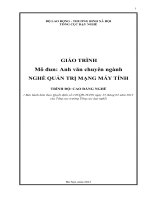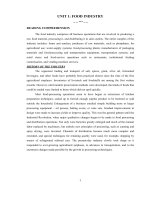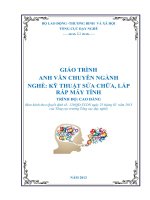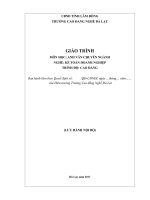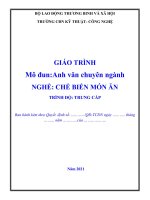Giáo trình Anh văn chuyên ngành bảo vệ thực vật (Nghề: Bảo vệ thực vật - Cao đẳng) - Trường Cao đẳng cộng đồng Đồng Tháp
Bạn đang xem bản rút gọn của tài liệu. Xem và tải ngay bản đầy đủ của tài liệu tại đây (2.05 MB, 88 trang )
UỶ BAN NHÂN DÂN TỈNH ĐỒNG THÁP
TRƯỜNG CAO ĐẲNG CỘNG ĐỒNG ĐỒNG THÁP
GIÁO TRÌNH
MƠN HỌC: ANH VĂN CHUN NGÀNH – BVTV
NGÀNH, NGHỀ: BẢO VỆ THỰC VẬT
TRÌNH ĐỘ: CAO ĐẲNG
(Ban hành kèm theo Quyết định Số:…./QĐ-CĐCĐ-ĐT ngày… tháng… năm
2021 của Hiệu trưởng Trường Cao đẳng Cộng đồng Đồng Tháp)
Đồng Tháp, năm 2017
COPYRIGHT DISCLAIMER
This work may be reproduced or distributed in education or references, except as
in any form or by any means of business purpose without permission.
i
PREFACE
English for Plant Protection is a new educational for Plant Protection
professionals who want to improve their English knowledge in a plant protection
context.
The course addresses popular topics related to plant protection in Mekong
Delta such as rice, vegetables, chemicles for fruit trees, roses, and nutrient
deficiencies.
The course is organized into 5 units, each part in a unit includes 2 main parts
as follow:
- Part 1: Content
- Part 2: Exercises
The course provides some following features:
- A variety of realistic reading passages
- Glossary of terms and phrases
- Reading comprehension exercises
Đồng Tháp, ngày 10 tháng 5 năm 2017
Chủ biên
Trầm Thị Ngọc Hương
ii
CONTENT
Page
PREFACE ....................................................................................................................... ii
UNIT 1: RICE ................................................................................................................1
1. Introduction: .................................................................................................. 1
1.1. General information: ..................................................................................... 1
1.2. Rice farming: ............................................................................................... 2
2. Diseases in rice plant: ...................................................................................... 8
2.1. Yellow dwarf disease: ................................................................................... 8
2.2. Ragged stunt disease: .................................................................................... 9
2.3. Causes: ........................................................................................................ 9
2.4. Management principles: ............................................................................. 9
UNIT 2: VEGETABLES .............................................................................................. 11
1. Soil preparation for growing vegetables:......................................................... 11
1.1. Overview: .................................................................................................. 11
1.2. Improvement: ............................................................................................. 12
2. Minimizing diseases in vegetable garden: ....................................................... 15
UNIT 3: CHEMICALS FOR FRUIT TREES ............................................................. 22
1. Overview: ..................................................................................................... 22
2. Chemicals for fruit trees: ............................................................................... 23
2.1. Fertilizers: .................................................................................................. 23
2.2. Bactericides:............................................................................................... 23
2.3. Fungicides:................................................................................................. 24
2.4. Pesticides: .................................................................................................. 24
3. Environmental effects of herbicide use: .......................................................... 26
UNIT 4: ROSES ..........................................................................................................30
1. Insect pests for roses: ..................................................................................... 30
1.1. Aphids: ...................................................................................................... 31
1.2. Japanese beetles:......................................................................................... 32
1.3. Leaf cutter bees: ......................................................................................... 32
2. Diseases in roses: .......................................................................................... 34
iii
2.1. Blackspot: .................................................................................................. 34
2.2. Powdery mildew:........................................................................................ 36
2.3. Bostrytis blight: .......................................................................................... 37
UNIT 5: NUTRIENT DEFICIENCIES .......................................................................39
1. Conception of nutrient deficiencies:................................................................ 39
2. Nutrient deficiencies: ..................................................................................... 41
2.1. Nitrogen deficiency: ................................................................................... 41
2.2. Potassium deficiency: ................................................................................. 42
2.3. Phosphorus deficiency: ............................................................................... 43
2.4. Magnesium deficiency: ............................................................................... 44
2.5. Manganese and iron deficiency: .................................................................. 45
FURTHER READING .................................................................................................48
GLOSSARY .................................................................................................................74
REFERENCE ...............................................................................................................79
iv
GIÁO TRÌNH MƠN HỌC
Tên mơn học: ANH VĂN CHUN NGÀNH - BVTV
Mã môn học: CNN451
Thời gian thực hiện môn học: 30 giờ (Lý thuyết: 27 giờ; Thực hành, thí nghiệm,
thảo luận, bài tập: 0 giờ; Kiểm tra thường xuyên, định kỳ: 1 giờ; ôn thi: 1 giờ;
Thi/kiểm tra kết thúc mơn học: 1 giờ)
Vị trí, tính chất, ý nghĩa và vai trị của mơn học:
- Vị trí: Mơn học tiếng Anh chuyên ngành Bảo vệ thực vật thuộc nhóm các mơn
học chun mơn được bố trí giảng dạy sau khi đã học xong các môn học đại
cương như là pháp luật, chính trị, tin học, giáo dục thể chất, giáo dục quốc phịng,
tiếng Anh 1-2-3.
- Tính chất: Nhằm trang bị cho sinh viên những kỹ năng tiếng Anh và kiến thức về
từ vựng cơ bản cho cây trồng nông nghiệp, cách chăm sóc, bảo vệ cây trồng, và một số
bệnh đặc trưng ở cây. Mơn học cịn giúp người học có thể tham khảo tài liệu hoặc các
sách Anh văn chuyên ngành, làm nền tảng để người học có thể tự học tiếng Anh chuyên
ngành ở cấp độ cao hơn.
- Ý nghĩa và vai trị của mơn học: mơn học tiếng Anh chuyên ngành Bảo vệ
thực vật là một môn học có ý nghĩa quan trọng của 2 ngành Bảo vệ thực vật và
ngành Khoa học cây trồng và có nó có vai trị hỗ trợ cho học sinh, sinh viên có
được kiến thức kỹ thuật trong tiếng Anh về trồng trọt và bảo vệ thực vật.
Mục tiêu của môn học
- Về Kiến thức:
+ Nâng cao từ vựng cơ bản về thực vật nơng nghiệp, cách chăm sóc và bảo
vệ thực vật, tránh một số bệnh đặc trưng của thực vật.
- Kỹ năng:
+ Sử dụng các cấu trúc từ vựng, các điểm ngữ pháp đã học để miêu tả về thực
vật.
+ Thảo luận viết và nói về các cách bảo vệ thực vật bằng tiếng Anh một cách
đơn giản.
- Về năng lực tự chủ và trách nhiệm:
+ Có ý thức tích cực, chủ động trong q trình học tập.
+ Trung thực trong kiểm tra và thi.
III. NỘI DUNG MÔN HỌC
Thời gian (giờ)
Số TT
1
Tên chương, mục
UNIT 1: RICE
1. Introduction
1.1. General information
Tổng
số
6
Lý
Thực hành, thảo Kiểm
thuyết
luận, bài tập
tra
6
0
0
v
2
3
4
1.2. Rice farming
2. Diseases in rice plant
2.1. Yellow dwarf disease
2.2. Ragged stunt disease
UNIT 2: VEGETABLES
1. Soil preparation for growing
vegetables
1.1. Overview
1.2. Improvement
2. Minimizing diseases in vegetable
garden
2.1. Choosing resistant or tolerant
varieties
2.2. Using treated seed
2.3. Free-of-disease seeds, transplants,
and propagating.
UNIT 3: CHEMICALS FOR FRUIT
TREES
1. Overview
2. Chemicals for fruit trees
2.1. Fertilizers
2.2. Bactericides
2.3. Fungicides
2.4. Pesticides
3. Environmental effects of herbicide
use
Kiểm tra
5
5
0
7
7
0
1
0
1
UNIT 4: ROSES
5
1. Insect pests for roses
1.1. Aphids
1.2. Japanese beetles
1.3. Leaf cutter bees
2. Diseases in roses
2.1. Blackspot
2.2. Powdery mildew
2.3. Bostrytis blight
4
4
0
0
vi
UNIT 5 : NUTRIENT
DEFICIENCIES
6
1. Conception of nutrient deficiencies
2. Nutrient deficiencies
2.1. Nitrogen deficiency
2.2. Potassium deficiency
2.3. Phosphorus deficiency
2.4. Magnesium deficiency
2.5. Manganese and iron deficiency
Ơn thi
5
5
0
1
1
Thi kết thúc mơn
1
1
TỔNG CỘNG
30
27
0
3
vii
UNIT 1
RICE
MH35-01
Introduction
On a global basis, rice ranks second only to wheat in terms of area
harvested, but in terms of its importance as a food crop, rice provides more
calories per hectare than any other cereal food grain.
Objectives:
By the end of the lesson, learners are able to:
+ Enhance reading skills through exercises of comprehension .
+ Understand meanings of new words and use in proper contexts.
1. Introduction
1.1.
General Information
Scientific name: Oryza sativa L.
Rice belongs to the Graminae grass family. On a global basis, rice ranks
second only to wheat in terms of area harvested, but in terms of its importance
as a food crop, rice provides more calories per hectare than any other cereal food
grain.
1
Figure 1.1. Paddy seeds
(Photo: Internet source)
Rice grows best in warm temperatures with plentiful moisture from rainfall
or irrigation, and is most frequently grown in valley and river deltas. The plant is
an annual, from 2 to 6 ft (61–183 cm) tall, with a round, jointed stem; long, pointed
leaves; and edible seeds borne in a dense head on separate stalks. Wild rice is
obtained from a different grass plant.
1.2.
Rice farming
Figure 1.2. Plowing
Figure 1.3. Harvest
(Photo: Internet source)
A typical method for casting flooded field rice growing is as follows:
Land
A leveled, flat landbed is surrounded by side earth walls, for
preparation water control. Then, the surrounded field is flooded until the
water level is approximately 1-2 cm high and allowed to sit for a
2
few days. The source of water could come from natural rainfall,
cannels, or a well.
Separate from the prepared ricefield, paddy seeds are soaked
Seed
overnight. The next morning, the seeds are drained and allowed
preparation to rest for a few days. The seed will sprout. (Seed preparation and
land preparation may be done at the same time.)
After the prepared land has been allowed to sit for a few days, it
is now ready for plowing. Farmers could plow the ricefield either
Plowing
by using modern machinary or using animal labor (i.e. water
buffaloes). Plowing is necessary to eliminate weed that could
grow overnight in the flooded field, without using chemicals.
Moreover, plowing also signifies the beginning of the rice
growing cycle.
Immediately after plowing, rice sprouts are transferred to the
Casting
plowed field. This transferring method is called casting. In
Thailand, hand casting by an experienced farmer is preferred, in
order to produce even rows of casting.
After casting, rice sprouts will mature to young plants in a few
days. Water is then drained into the field until its level reaches
Resting
that of the lowest leaves on the rice plant; however, the water
level must not exceed 2-3 cm high. For the next 1-2 months, rice
plants will be left to grow into paddy and turn lightbrown in
color. In the mean time, the rice field remains constantly flooded.
Draining
3
Once the rice paddy turns light brown, water is drained, and the
field is left to dry.
Harvest
After the drained field is completely dry, and the plant turns to
hay color, the paddy is harvested either by a sickle or a machine.
Table 1.1: A typical method for casting flooded field rice growing
Exercises:
Task 1: Read part 1.1 and decide whether the statements are T (True) or F
(False).
1. ____ Plowing is also a non-chemical way to eliminate weed.
2. ____ Land preparation and casting may be done at the same time.
3. ____ Draining water is done because the field needs to be dried for harvest.
4. ____ Side earth walls surrounding a leveled, flat landbed are used for walking
around.
5. ____ After casting, water level reaches the leaves on the rice plant, but not
exceed 2-3 cm high.
6. ____ The paddy is harvested by a sickle or a combine harvester.
7. ____ It is not necessary to make seed sprout in modern casting method today.
8. ____ Farmers can disorder the typical method for rice growing.
9. ____ Paddy seeds are inedible.
10. ____ Rice is one of important food crops in the world.
Task 2: Fill in the blanks with words/phrases in the box.
water control
edible
casting
harvest
water
temperature
calories
hand casting
water buffaloes
pointed
terraced field
growing cycle
4
1. The rice plant is about 61cm tall, with a round, jointed stem; long, _______
leaves; and _________ seed.
2. _________ is one of natural factors that almost presents in seven steps of rice
farming.
3. Side earth walls are used for ____________________.
4. The time for farmers’ resting is after ____________.
5. Rice provides more ____________ per ha than any other cereal food grain.
6. That the rice paddy turns light brown is the time of _________ preparation.
7. Landbed can be plowed by modern machinary or using animal labor like
_______________.
8. In mountain region, farmers grow the paddy in ________________.
9. Plowing also signifies the beginning of the rice ________________.
10. In Thailand, _____________ by an experienced farmer is preferred.
1.3.
Diseases in rice plant
Yellow dwarf disease
Symptoms
Figure 1.4. Symptoms of rice plants inflected yellow dwarf disease
(Photo: Internet source - bannhanong.vn)
The disease is characterized by general chlorosis, with pronounced stunting
and profused tillering.
5
The chlorotic leaves are uniformly pale-green or pale-yellow. Discoloration
first appears on the emerging young leaves and then chlorosis on all the
succeeding leaves.
Plants infected early may die prematurely. Those which survive until
maturity produce only either no panicle at all or a few small panicles with
unfilled grains.
Plants infected in the late growing stage may show chlorotic branches
arising from upper nodes or small chlorotic tillers in the stubble, or no other
symptom except distortion of panicles, or characteristic chlorosis tillering
on the ratoon grown on the cut stubbles.
This disease is caused by phytoplasmas and these are generally observed in
phloem tubes of yellow dwarf infected rice plants.
Identification pathogen
The Mycoplasma Like Organism is transmitted by Nephotettix virescens
and N. nigropictus with a latent period of 25-30 days.
It survives on several grass weeds.
Management strategies
Deep ploughing during summer and burning of stubbles.
Rice varieties are resistant to the disease.
Avoiding early-planted rice will prevent an increase in vector density and
proportion of infected vectors.
Planting fallow rice fields with non-vector hosts, ploughing fallow paddy
fields, and late-planting, synchronous planting, or avoiding an overlap of
early-and late-planted rice crops.
6
Figure 1.5. Deep ploughing to control disease pathogen
(Photo: Internet source)
Exercises
Task 1: Read part 1.2.1 and complete the following blanks.
1/ Symptoms of yellow dwarf disease on the young leaves are ___________ and
on the succeeding leaves are _____________ .
2/ Cause of this disease is ________________ .
3/ The period which plants are inflected is _____________.
4/ Pathogen survives on some _____________.
5/ Beside using resistant rice, for soil, ____________ is also one of management
strategies.
Task 2: Refer part 1.2.1 and translate into Vietnamese.
1. Burning of stubbles and deep ploughing are the ways to limit the disease.
……………………………………………………………………………….
……………………………………………………………………………….
2. The latent duration pathogen may be 25-30 days. It also survives on several
grass weeds.
……………………………………………………………………………….
……………………………………………………………………………….
7
3. The emerging young leaves first appears discoloration, and then chlorosis
starts on all the succeeding leaves.
……………………………………………………………………………….
……………………………………………………………………………….
4. The disease causes distortion of panicles, or characteristic chlorosis tillering
on the ratoon grown on the cut stubbles.
……………………………………………………………………………….
……………………………………………………………………………….
2. Ragged stunt disease
Disease name: Rice ragged stunt virus (RRSV)
2.1. Symptoms
Figure 1.6. Symptoms of inflected leaves
(Photo: Internet source)
Stunting during early growth stages of the crop.
Infected plants severely stunted during early growth stages of the crop.
Leaves are short and dark green with serrated edges.
Leaf blades are twisted at the apex or base, which result in the spiral
shape of the leaves.
Leaf edges are uneven and the twisting give the leaves a ragged
appearance.
Ragged portions of the leaves are yellow to yellow-brown.
Vein swellings develop on the leaf blades and sheaths.
Swellings are pale yellow or white to dark brown.
Flag leaves twisted, malformed, and shortened at booting stage.
8
Flowering is delayed.
Incomplete panicle emergence.
Nodal branches produced at upper nodes.
Partially exserted panicles and unfilled grains.
2.2. Factors favoring development disease
- Presence of the vector and the host.
- Tillering, reproductive, and maturity growth stages of the rice plant.
Figure 1.7. Shapes of inflected paddy panicles
(Photo: Internet source)
2.3. Causes
The infection and the vector density are very high in tropical regions where rice
is planted year-round.
The presence of the vector and the host continuously support the development of
infection or pathogen.
2.4. Management principles
There are no specific control measures for the ragged virus disease except for the
use of resistant varieties because some rice varieties are resistant to the brown
planthopper, to the virus, and to both.
Cultivars resistant to the vector have low disease incidence.
Practice synchronized planting.
Plow infected stubbles under the field after harvest to reduce the virus
source.
Exercises
Task 1: Read part 1.2.2 and answer the following questions.
9
1/ What parts of rice plant have got symptoms of diseases?
…………………………………………………………………..
2/ What part of rice plant has the most distinct appearance of symptoms?
…………………………………………………………………..
3/ How are parts of leaves inflected?
…………………………………………………………………..
4/ List forms and shapes of inflected leaves.
…………………………………………………………………..
5/ Is the early growth stage of crop attacked by the disease?
…………………………………………………………………..
6/ Where are the places of very high inflection?
…………………………………………………………………..
7/ Apart from using resistant varieties, what is being used in temperate countries
to reduce disease incidence?
…………………………………………………………………..
Task 2: Refer part 1.2.2 and translate into English.
1. Nơi phồng to của gân lá có màu vàng nhạt, trắng hoặc nâu sậm.
……………………………………………………………………………….
2. Mầm bệnh dễ lây lan ở những nơi mà cây lúa được trồng quanh năm.
……………………………………………………………………………….
3. Sử dụng giống kháng bệnh cũng góp phần ngăn ngừa và làm giảm được bệnh.
……………………………………………………………………………….
4. Triệu chứng của bệnh biểu hiện qua sự thay đổi màu sắc, hình dạng trên các
bộ phận của lá như phiến lá, mép lá và gân lá.
……………………………………………………………………………….
10
UNIT 2
VEGETABLES
MH35-02
Introduction
Improving the soil used to grow vegetables is one of the best ways to see
bigger plants, more produce and fewer problems.
Objectives:
By the end of the lesson, learners are able to:
+ Enhance reading skills through exercises of comprehension such as
skimming for main ideas, categorizing words with their meanings.
+ Understand meanings of new words and use in proper contexts.
1. Soil preparation for growing vegetables
1.1. Overview
Improving the soil used to grow vegetables is one of the best ways to see
bigger plants, more produce and fewer problems. In general, garden soil should
be loamy (or sandy and loamy), with plenty of organic matter. Soil should be
tailored to meet the needs of specific vegetables whenever possible to improve
your results. For example, tomatoes require plenty of organic matter and acidic
soil where carrots cannot tolerate the same acidity and prefer a loose soil without
stones or clumps.
11
Figure 2.1. Farmers are preparing soil for growing vegetables
(Photo: Ngo Diu)
1.2. Improvement
Step 1
Loosen the soil by tilling or digging and turning. Roots will be able to more
easily penetrate soil that has been broken apart. This process also helps create
pockets of air to supply oxygen that roots need to thrive. Heavy clay soil
compacts, holding too much water, preventing air from getting to roots and roots
from being able to develop well.
Step 2
Improve drainage. According to Mississippi State University, heavy soils
like clay don't drain well, while sandy soil may drain too quickly. In very poor
soils or areas with drainage trouble that resists repair, raised beds may be a better
way to garden.
12
Figure 2.2. Raising winding beds to keep water irrigated in inclined terrains
(Photo: Internet source)
Step 3
Add organic matter to increase the level of nutrients available to plants.
Organic matter can help hold water and keep roots moist. It can also be used to
improve very sandy, clay ridden or densely packed soils. Add soil conditioners to
improve structure. These include sawdust, coarse sand and perlite. Some additions
do double duty as conditioner and organic matter, including compost and peat
moss.
Step 4
Plant a cover crop. Also called green manure, cover crops include legumes
(such as clover and vetch) and cereal grains (like oats, wheat or rye). Such growth
keeps weeds out of the garden space during months it is not in use, adds nitrogen
and fertility to the soil and fights erosion.
Step 5
Test the soil pH. Soil pH makes different nutrients more or less available
to plants for use. Certain plants require specific amounts of various nutrients
(Nitrogen, Potassium and Phosphorous in particular) in order to resist disease and
achieve their best rate of growth.
Exercises
Task 1: Read part 2.1 and provide the following information.
There are five main steps of improvement to make soil. They are:
13
1/ ………………………………………………………………...
2/ ………………………………………………………………...
3/ ………………………………………………………………...
4/ ………………………………………………………………...
5/ ………………………………………………………………...
Task 2: Refer part 2.1 and sort the words in the box to the same topics.
wheat
very sandy
alkaline soil
rice
animal manure
peat moss
heavy clay
sawdust
compost
millet
oat
densely packed soils
infertile soil
rye
Soil
…………….
…………….
…………….
…………….
…………….
Cereal grain
…………….
…………….
…………….
…………….
……………..
Organic matter
…………….
…………….
…………….
……………..
……………..
14
2. Minimizing diseases in vegetable garden
Plants sometimes get sick. Vegetable plants usually are capable of fending off
disease-causing bacteria, viruses, and fungi. But if conditions favor the disease
and plants are weak, the disease sometimes gains the upper hand, often leading to
early death of the plants.
The tips below will help gardeners minimize the effects of plant diseases on the
garden by employing two basic strategies:
Keep plants as strong and healthy as possible.
Minimize the conditions that favor disease and its spread.
Figure 2.3. Taking care of the vegetable garden
(Photo: Ngo Thanh)
Choosing resistant or tolerant varieties
This is the easiest and most important way to reduce diseases in the garden.
Resistant varieties resist infection by a particular disease agent and show little or
no disease. Tolerant varieties may show symptoms of the disease, but still yield
the same as resistant varieties or susceptible varieties protected by pesticides.
Using treated seed
Seed may come pretreated with a dusting of fungicide. This coating will help
prevent the seed from rotting in the soil before germination and help protect the
emerging seedling from a harmful "damping off" pathogen that girdles and kills
15
young plants shortly after they emerge. If seed rot or damping-off has been a
problem in the garden, treating seed with a fungicide will help.
Figure 2.4. Whole seeds and seeds treated
(Photo: )
Free-of-disease seeds, transplants, and propagating material
Start with healthy plant material to help plants get established quickly. Unhealthy
plant material will never yield as much as healthy material. Worse, plants may die
while they are still young. Reputable seed companies sell only disease-free plant
materials. Some seeds are treated with hot water to remove infectious agents, and
then tested to reduce the risk of seed-borne viruses. When shopping for transplants
or other propagating material, take time to examine the plants to make sure they
are healthy and vigorous.
Choosing a sunny, well-drained location
Most vegetable crops thrive in full sun. Shady, poorly drained sites produce weak,
spindly plants that are easy targets for disease organisms. Even if such plants
survive free of disease infections, they will not yield as much as strong, healthy
plants.
Improving the soil
When a garden site has heavy, wet soil, plant in raised beds or ridged rows so that
the soil around plants' roots won't be waterlogged. Heavy, wet soils discourage
healthy root growth and encourage root rots. If a garden is planted on a slope,
16
build terraced beds to reduce soil erosion over delicate, young plants and newly
sown seed. Soils that are dry and sandy can be mulched with straw, grass
clippings, black plastic, or other materials to retain moisture. A soil that is
favorable to healthy root development supports the growth of healthy plants.
Figure 2.5. Sandy, loamy and clayed soil
(Photo: />
Watering carefully
For best growth, plants usually require about 1 inch of water per week. If it doesn't
get enough rain, water the garden. Water plants in the morning so that the foliage
dries quickly. This reduces the spread of disease. Avoid using sprinklers if
possible because they promote the spread of leaf, flower, and fruit infections.
Trickle irrigation is a better choice because it delivers water directly to the soil
without getting the rest of the plant wet. It also doesn't splash soil onto the plants,
which can move pathogens from the ground onto the plant. (Mulches can also
help reduce soil splashing.)
Adequate fertilizer
Plants that are fertilized properly at planting and during the season will grow
better and be healthier. Use a complete and balanced fertilizer or incorporate wellrotted manure or rich compost into the soil. Avoid over-fertilizing because it can
damage roots.
17

